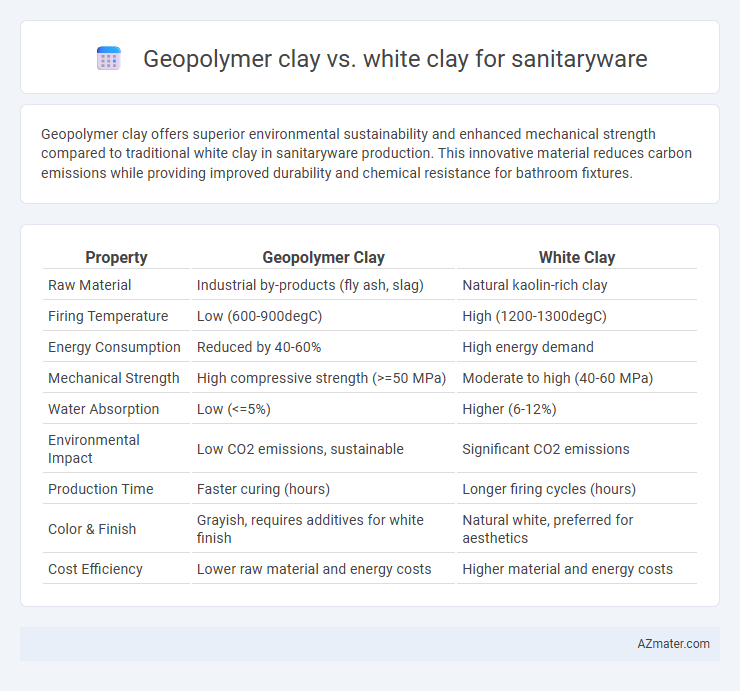Geopolymer clay offers superior environmental sustainability and enhanced mechanical strength compared to traditional white clay in sanitaryware production. This innovative material reduces carbon emissions while providing improved durability and chemical resistance for bathroom fixtures.
Table of Comparison
| Property | Geopolymer Clay | White Clay |
|---|---|---|
| Raw Material | Industrial by-products (fly ash, slag) | Natural kaolin-rich clay |
| Firing Temperature | Low (600-900degC) | High (1200-1300degC) |
| Energy Consumption | Reduced by 40-60% | High energy demand |
| Mechanical Strength | High compressive strength (>=50 MPa) | Moderate to high (40-60 MPa) |
| Water Absorption | Low (<=5%) | Higher (6-12%) |
| Environmental Impact | Low CO2 emissions, sustainable | Significant CO2 emissions |
| Production Time | Faster curing (hours) | Longer firing cycles (hours) |
| Color & Finish | Grayish, requires additives for white finish | Natural white, preferred for aesthetics |
| Cost Efficiency | Lower raw material and energy costs | Higher material and energy costs |
Introduction to Geopolymer Clay and White Clay
Geopolymer clay is an innovative material synthesized through the alkaline activation of aluminosilicate sources, offering enhanced mechanical strength and environmental benefits compared to traditional clays. White clay, commonly kaolin, is a naturally occurring fine-grained material valued for its purity, plasticity, and whiteness, widely used in sanitaryware for its smooth finish and high firing temperature stability. The comparison between geopolymer and white clay centers on their differing compositions, firing processes, and performance attributes, influencing durability, aesthetics, and sustainability in sanitaryware production.
Composition and Material Properties
Geopolymer clay for sanitaryware primarily consists of aluminosilicate minerals combined with alkaline activators, offering superior chemical resistance and thermal stability compared to traditional white clay. White clay, typically kaolin-based, is rich in kaolinite with high plasticity and whiteness, providing excellent workability but lower mechanical strength. The geopolymer material exhibits enhanced durability and dimensional stability, making it more suitable for modern sanitaryware applications requiring high performance and environmental sustainability.
Manufacturing Process Differences
Geopolymer clay for sanitaryware is produced through a low-temperature chemical activation process involving alkali-activated materials, resulting in energy-efficient curing compared to traditional high-temperature firing of white clay. The geopolymer manufacturing process reduces carbon emissions by eliminating the need for kiln firing at temperatures above 1,200degC, unlike the conventional white clay method that relies on extensive heating to achieve vitrification and strength. This difference in production significantly influences resource consumption, making geopolymer clay a more sustainable alternative in sanitaryware manufacturing.
Environmental Impact and Sustainability
Geopolymer clay for sanitaryware significantly reduces carbon emissions by utilizing industrial byproducts like fly ash, offering a sustainable alternative to traditional white clay that requires intensive mining and high-temperature firing. The low energy consumption during geopolymer production minimizes environmental degradation and resource depletion compared to white clay, which relies heavily on natural clay deposits and generates more waste. Implementing geopolymer clay in sanitaryware manufacturing supports circular economy principles and reduces landfill impact, making it a more eco-friendly choice for sustainable construction materials.
Strength and Durability Comparison
Geopolymer clay exhibits superior compressive strength and enhanced chemical resistance compared to white clay, making it highly suitable for durable sanitaryware applications. Its molecular structure provides resistance to cracking and wear, ensuring long-lasting performance under frequent water exposure. White clay, while traditionally used, tends to have lower mechanical strength and may be more susceptible to degradation over time in high-moisture environments.
Water Absorption and Porosity
Geopolymer clay exhibits significantly lower water absorption rates, typically around 2-4%, compared to white clay, which ranges between 5-8%, enhancing the durability of sanitaryware products. The porosity of geopolymer clay is reduced due to its dense molecular structure, resulting in less capillary action and improved resistance to moisture penetration. These characteristics make geopolymer clay a superior choice for sanitaryware applications where low water absorption and minimal porosity are critical for longevity and hygiene.
Aesthetic Qualities and Design Flexibility
Geopolymer clay offers superior aesthetic qualities for sanitaryware with its natural matte finish and consistent color stability, enhancing modern minimalist designs. White clay provides a traditional glossy surface ideal for classic sanitaryware, but its limited color variation restricts innovative design approaches. The inherent malleability of geopolymer clay allows for intricate shapes and customizable textures, expanding creative possibilities beyond the uniformity of white clay products.
Cost Effectiveness and Market Availability
Geopolymer clay offers cost-effectiveness in sanitaryware production due to lower raw material costs and reduced energy consumption compared to traditional white clay. White clay remains widely available and preferred in the market for its proven performance, but its higher extraction and processing expenses impact overall manufacturing costs. Market availability of geopolymer clay is growing as industries seek sustainable, affordable alternatives to standard white clay in sanitaryware applications.
Health and Safety Considerations
Geopolymer clay offers a lower emission of volatile organic compounds (VOCs) and heavy metals compared to traditional white clay, reducing respiratory and skin irritation risks during sanitaryware manufacturing. Its inert chemical composition minimizes hazardous dust generation, enhancing workplace air quality and decreasing long-term occupational health hazards. White clay, while widely used, may release silica dust and trace impurities that require stringent protective measures to prevent silicosis and other respiratory illnesses in production environments.
Future Trends in Sanitaryware Materials
Geopolymer clay offers enhanced durability, lower carbon footprint, and superior thermal resistance compared to traditional white clay, making it a promising material for eco-friendly sanitaryware production. Innovations in geopolymer technology enable faster curing times and increased chemical resistance, aligning with future sustainability and performance demands in the sanitaryware industry. Industry trends indicate a growing adoption of geopolymer-based composites driven by regulatory pressures and consumer preference for sustainable building materials.

Infographic: Geopolymer clay vs White clay for Sanitaryware
 azmater.com
azmater.com